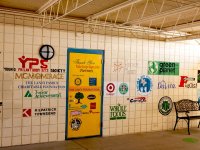Growing a Community to Build a Garden
Tapping your community for funds, resources, and labor isn’t easy, but with planning, persistence, and good will, rallying local support for a major school project benefits everyone.
When Walter Bracken STEAM Academy Elementary School began its gardening program 15 years ago with one small area, we immediately saw the excitement and benefit for the students. And so we set ourselves an eventual goal to increase the number of garden beds so that every classroom would have one of its own. We also learned about a local group called Garden Farms of Nevada, who we hired to provide support from a gardener. This really helped us ensure schoolwide consistency with our program. As a side benefit of creating gardens, we also conserved water through grass replacement. This created a win-win program for our school.
On September 27, 2014, Walter Bracken participated in the Green Apple Day of Service in conjunction with the U.S. Green Building Council (USGBC) of Southern Nevada. With the help of 100 volunteers, the school removed its final 4,000 square feet of grass. This was important because grass areas consume a lot of extremely valuable water in Las Vegas. The project not only saved water in our valley, but also added raised-bed gardens to support our curriculum and provide healthy vegetables for our at-risk students.
Building a Better Garden
In order to build this project, which included seven 8x5-foot raised beds, we needed a lot of financial and labor support. Had we just contracted someone to build this garden, it might have cost over $35,000. However, because we had a partner working with us, we were able to raise the money needed and get the job done. We started with a plan for the garden area which included the installation of artificial turf. We called local companies with whom we'd worked in the past to get as many donations as possible.
Our partner, Green Our Planet, supports local schools that build school gardens. This organization came out to help us in a number of ways, including this crowdfunding video:
The video clearly described our project and what we were hoping to accomplish. After it was produced, we shared it on our Facebook page. Then we reached out to previous partners such as Parsons for the turf and Pierros Landscaping, who helped with the design and quote to finish the work that we couldn't do for ourselves. Our partnership with Leadership Las Vegas led us to Los Vaqueros, who donated a cement mixer. We had a former staff member who was great with concrete and helped us put the garden bed footers in place. Every bit of labor that we could do by ourselves helped reduce the cost. Our USGBC partners helped us get donations from Home Depot and Cemex. It became the combined effort of everyone at the school and our partners to help us get all of the support that we needed. Our local Rotary Club jumped in to provide support from individual members. Even our own school board representative came out to dig ditches for the beds.
You can reference the Green Our Planet site to see the other individuals who contributed to the overall project. In addition to these people and companies, we also received a rebate from our water district for removing the grass, which helped us reach our campaign's funding goal. The project day involved so many different groups to finish up the work, including two local high schools and the Downtown Rangers and Las Vegas Downtown Achieves. It really was an entire community effort.
8 Steps to Community Partnership
There are many schools that don't reach out to their community for help with huge projects. While it can be a lot of work to coordinate, the benefits make it all worthwhile. After this project was done, it was much easier to raise $20,000 for another garden project at Walter Long Elementary School. Our partners easily see the direct benefit to our kids and to the valley when partnering with our schools.
So let's make it easier for you:
- Start with a vision of a project that can include hands-on support from the community. It can be a garden, a school makeover, murals, or adding trees.
- Reach out to local groups who share that interest and may have ideas of how they can help.
- Reach out to businesses who can provide the things that you'll need -- concrete, paint, brushes, and supplies such as snacks and water for the volunteers. Ask specifically for this kind of material support. It's critical to getting what you need and much more effective than just asking for money.
- Reach out to everyone who can help out on the day of the event. Consider your feeder schools as well -- they can turn it into a community service day.
- Look for service organizations such as Scouts, ROTC, church groups, United Way, Rotary, and any other such groups in your area.
- Have sign-in sheets on the day of service. This makes it easy to thank everyone involved.
- Celebrate the completion of your project with a ribbon-cutting event which can even include your local Chamber of Commerce.
- Follow up with those groups when you are using the space that they so generously helped you create. Invite them to return for reading week or career day events. Once you bring them in, keep them engaged in your program. As a community, you can benefit the students in ways that would be impossible if your school attempted it without support.
Walter Bracken STEAM Academy Elementary School
Enrollment
527 | Public, UrbanPer Pupil Expenditures
$9402 School • $8576 StateFree / Reduced Lunch
56%DEMOGRAPHICS:
This blog post is part of our Schools That Work series, which features key practices from Walter Bracken STEAM Academy Elementary School.
